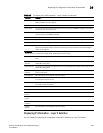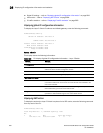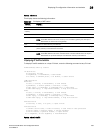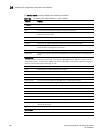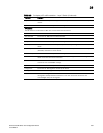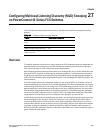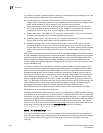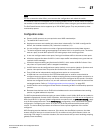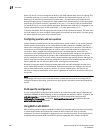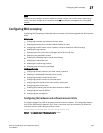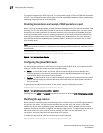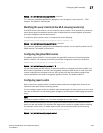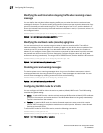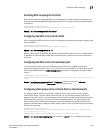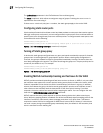
PowerConnect B-Series FCX Configuration Guide 891
53-1002266-01
Overview
27
NOTE
For this command to take effect, you must save the configuration and reload the switch.
The hardware resource limit applies only to snooping-enabled VLANs. In VLANs where snooping is
not enabled, multicast streams are switched in hardware without using any pre-installed resources.
The Dell PowerConnect device supports up to 32K of MLD groups. They are produced by client
membership reports.
Configuration notes
• Servers (traffic sources) are not required to send MLD memberships.
• The default MLD version is V1.
• Hardware resources are installed only when there is data traffic. If a VLAN is configured for
MLDv2, the hardware matches (S G), otherwise it matches (* G).
• You can configure the maximum number of groups and hardware-switched data streams.
• The device supports static groups applying to the entire VLAN, or to specific ports. The device
acts as a proxy to send MLD reports for the static groups when receiving queries.
• A user can configure static router ports, forcing all multicast traffic to be sent to these ports.
• All devices support fast leave for MLDv1, which stops traffic immediately to any port that has
received a leave message.
• All devices support tracking and fast leave for MLDv2, which tracks all MLDv2 clients. If the
only client on a port leaves, traffic is stopped immediately.
• An MLD device can be configured as a querier (active) or non-querier (passive). Queriers send
queries. Non-queriers listen for queries and forward them to the entire VLAN.
• Every VLAN can be independently configured as a querier or a non-querier.
• A VLAN that has a connection to an IPv6 PIM-enabled port on another router should be
configured as a non-querier. When multiple snooping devices connect together and there is no
connection to IPv6 PIM ports, only one device should be configured as the querier. If multiple
devices are configured as active, only one will continue to send queries after the devices have
exchanged queries. Refer to “Configuring queriers and non-queriers” on page 892.
• An MLD device can be configured to rate-limit the forwarding of MLDv1 membership reports to
queriers.
• Because these devices use an IPv6 link-local address as the source address when sending
queries, no global address is required.
The MLD implementation allows snooping on some VLANs or on all VLANs. MLD can be enabled or
disabled independently for each VLAN. In addition, individual ports of a VLAN can be configured as
MSLv1 and MLDv2. In general, global configuration commands such as ipv6 mld-snooping... apply
to all VLANs except those with a local mld-snooping.. configuration, which supersedes the global
configuration. Configuring the version on a port or a VLAN only affects the device sent query
version. The device always processes all versions of client reports regardless of the version
configured.
MLD Snooping requires hardware resources. If the device has insufficient resources, the data
stream without a resource is mirrored to the CPU in addition to being VLAN flooded, which can
cause high CPU usage. To avoid this situation, Dell recommends that you avoid enabling snooping
globally unless necessary.



